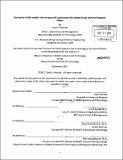| dc.contributor.advisor | Ernst Berndt. | en_US |
| dc.contributor.author | Dhavale, Todd V | en_US |
| dc.contributor.other | Harvard University--MIT Division of Health Sciences and Technology. | en_US |
| dc.coverage.spatial | n-us--- e------ | en_US |
| dc.date.accessioned | 2012-01-12T19:29:55Z | |
| dc.date.available | 2012-01-12T19:29:55Z | |
| dc.date.copyright | 2011 | en_US |
| dc.date.issued | 2011 | en_US |
| dc.identifier.uri | http://hdl.handle.net/1721.1/68465 | |
| dc.description | Thesis (S.M.)--Harvard-MIT Division of Health Sciences and Technology, 2011. | en_US |
| dc.description | Cataloged from PDF version of thesis. | en_US |
| dc.description | Includes bibliographical references (p. 66-73). | en_US |
| dc.description.abstract | The United States is the world leader in development and manufacture of medical devices. Even with this leadership position, there is evidence that the US is often not the first country to have new medical technology approved for patient use. In many cases, the European Union is the first geographic region to approve a new medical technology for sale, with US approval coming later. This delay in approval of new devices between the EU and US is referred to as the "device lag." However, the extent or history of this lag over time and for different device types has not been examined. This thesis evaluated if a device approval lag has developed between US and EU at any time over the past 20 years and whether a device lag continues to exist today. US and EU regulatory approval data for 135 medical devices in three innovative medical device segments were collected and analyzed to evaluate the extent and history of the approval lag between the European Union and the United States. The collected approval data revealed a consistent approval lag between the US and EU in each of the three medical device segments explored in this study. Throughout the entire 20+ years of study, the United States had an average approval lag to the European Union in each of the three device segments, and an average lag for all devices of 21 months or almost 2 years (Ho: p. = 0, p = 8.2E-12). Furthermore, the device lag in these three segments has grown in recent years. These data are striking because they show, perhaps for the first time, that an approval lag has existed for medical devices between the US and EU for the past 20 years - since the beginning of the pan-European device regulatory system in the mid-1990s. The device lag is a useful metric for comparing the attractiveness of two markets for medical technology and may signal important changes in the medical technology industry. Furthermore, the existence of a persistent device approval lag in the United States may have significant implications for patients and their caregivers. | en_US |
| dc.description.statementofresponsibility | by Todd V. Dhavale. | en_US |
| dc.format.extent | 87 p. | en_US |
| dc.language.iso | eng | en_US |
| dc.publisher | Massachusetts Institute of Technology | en_US |
| dc.rights | M.I.T. theses are protected by
copyright. They may be viewed from this source for any purpose, but
reproduction or distribution in any format is prohibited without written
permission. See provided URL for inquiries about permission. | en_US |
| dc.rights.uri | http://dspace.mit.edu/handle/1721.1/7582 | en_US |
| dc.subject | Harvard University--MIT Division of Health Sciences and Technology. | en_US |
| dc.title | Evaluation of the medical device approval lag between the United States and the European Union | en_US |
| dc.type | Thesis | en_US |
| dc.description.degree | S.M. | en_US |
| dc.contributor.department | Harvard University--MIT Division of Health Sciences and Technology | |
| dc.identifier.oclc | 769906879 | en_US |
